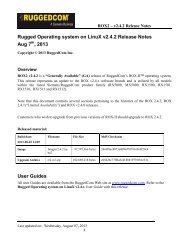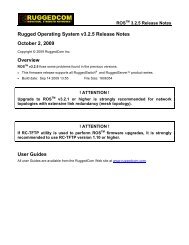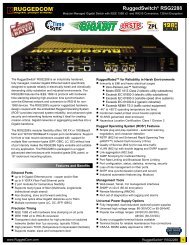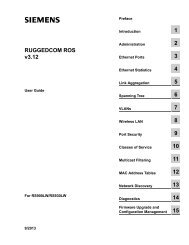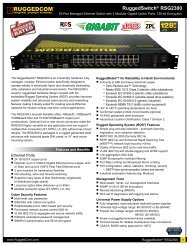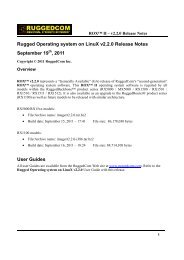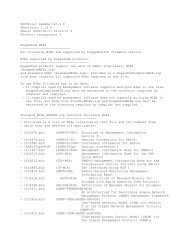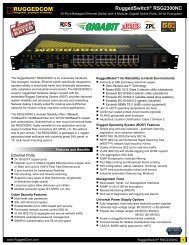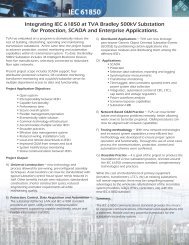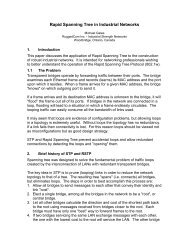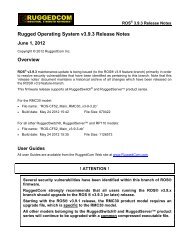Performance of the rapid spanning tree protocol in ... - RuggedCom
Performance of the rapid spanning tree protocol in ... - RuggedCom
Performance of the rapid spanning tree protocol in ... - RuggedCom
You also want an ePaper? Increase the reach of your titles
YUMPU automatically turns print PDFs into web optimized ePapers that Google loves.
4.2 Root Bridge FailureUnfortunately, <strong>the</strong> additional complexity <strong>of</strong> meshed topology causes root bridge failure failover times to<strong>in</strong>crease compared with <strong>the</strong> simple r<strong>in</strong>g. The problem <strong>of</strong> <strong>the</strong> root bridge failure scenario is that, after <strong>the</strong>failure, every switch hold<strong>in</strong>g <strong>the</strong> obsolete Root <strong>in</strong>formation is feed<strong>in</strong>g it back to <strong>the</strong> network, thus“confus<strong>in</strong>g” all o<strong>the</strong>r switches and mak<strong>in</strong>g <strong>the</strong>m “reject” <strong>the</strong> right new Root <strong>in</strong>formation. The sameproblem exists <strong>in</strong> <strong>the</strong> r<strong>in</strong>g topology as well but, due to <strong>the</strong> topology simplicity, <strong>the</strong>re are no loops where<strong>the</strong> obsolete <strong>in</strong>formation would circulate and <strong>the</strong> “confusion” is fixed very quickly. This is not <strong>the</strong> case <strong>in</strong>meshed networks.A meshed network can be looked at as multiple smaller r<strong>in</strong>gs <strong>in</strong>terconnected with each o<strong>the</strong>r at multiplepo<strong>in</strong>ts. This topology allows <strong>the</strong> obsolete Root <strong>in</strong>formation to circulate multiple times back and forth<strong>in</strong>side and between <strong>the</strong> smaller r<strong>in</strong>gs. The network will not be confused forever - accord<strong>in</strong>g to <strong>the</strong> RSTPstandard, <strong>the</strong> old <strong>in</strong>formation will be aged out after it traverses <strong>the</strong> maximum allowed number <strong>of</strong> hops(normally 20). However, <strong>the</strong> network outage time can last as long as seconds. It is caused by <strong>the</strong> fact thatmultiple switches <strong>in</strong> <strong>the</strong> network are cont<strong>in</strong>uously busy with process<strong>in</strong>g and forward<strong>in</strong>g contradictoryBPDUs be<strong>in</strong>g cont<strong>in</strong>uously received on different ports.Root bridge failure <strong>in</strong> a meshed network is very hard to analyze and predict, and a result may be totallydifferent for every specific topology. The common conclusion is though, that <strong>the</strong> root bridge failover timegrows exponentially as more redundant paths are added to <strong>the</strong> network topology. The root bridge failure<strong>in</strong> meshed topology is a well recognized problem. Although some proprietary mechanisms are <strong>of</strong>fered to<strong>in</strong>directly improve <strong>the</strong> RSTP performance, no common solution is known for this case. This is <strong>the</strong> pricepaid for <strong>the</strong> high level <strong>of</strong> l<strong>in</strong>k redundancy provided by meshed network topology.17



